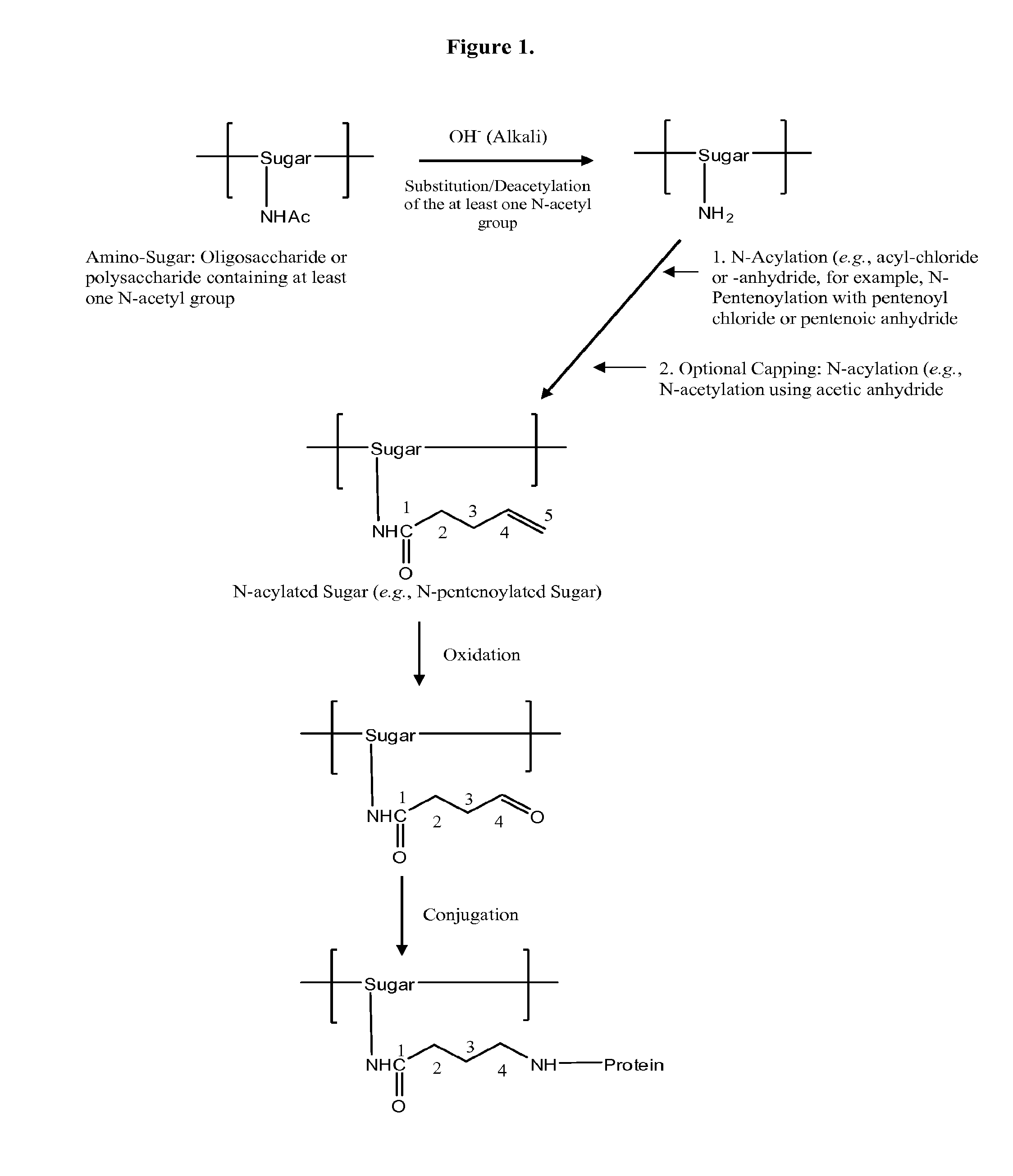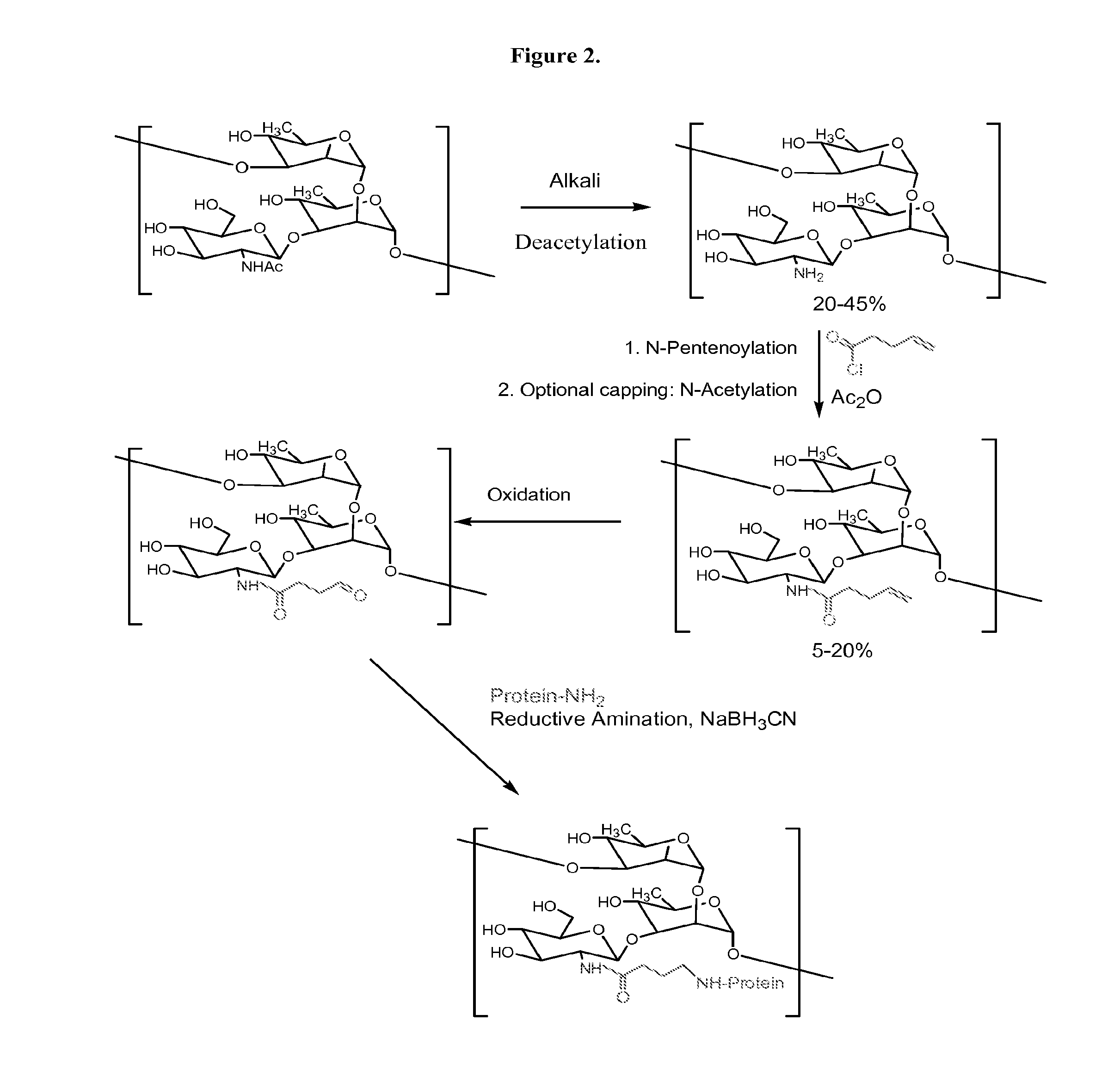Modified Polysaccharides for Conjugate Vaccines
a conjugate vaccine and polysaccharide technology, applied in the direction of carrier-bound antigen/hapten ingredients, immunological disorders, antibody medical ingredients, etc., can solve the problems of gram-negative bacteria being a significant cause of morbidity and mortality, infants and young children typically have poor immunogenic response to polysaccharide antigens, and other problems
- Summary
- Abstract
- Description
- Claims
- Application Information
AI Technical Summary
Benefits of technology
Problems solved by technology
Method used
Image
Examples
example ii
6.2 Example II
Group A Streptococcus (GAS) Polysaccharide-Protein Conjugates
Substitution of a Portion (35-40%) of the N-Acetyl Groups of GAS Polysaccharide
[0122]GAS polysaccharide (30 mg / ml) in 0.012N NaOH was treated with NaBH4 (8 mg / ml) for 75 min with stirring at room temperature ((RT) about 20-25° C.). 3N NaOH (½ of the volume of 0.012 N NaOH) was added into the reaction mixture with stirring to achieve a final concentration of GAS polysaccharide of 20 mg / ml. The reaction mixture was then maintained at 80° C. for 1 h. It was then cooled to RT and diluted with water to a final GAS polysaccharide concentration of 4 mg / ml. It was diafiltered against water using 3K regenerated cellulose membrane in Stir-cell. A 15× volume of water was used for diafiltration to achieve a concentration of GAS of 24 mg / ml. The degree of substitution of N-Acetyl Groups with primary amino groups was monitored by 1H-NMR spectroscopy.
N-Acylation (for Example, N-Pentenoylation) (15-25%) of N-Acetyl Group-Sub...
example iii
6.3 Example III
Meningococcal B Polysaccharide-Protein Conjugates
N-Acylation (for Example, N-Pentenoylation) (15-25%) of N-Acetyl Group-Substituted-Group-Substituted Meningococcal B Polysaccharide
[0128]4-pentenoyl chloride (1 ml / 100 mg of polysaccharide) in 1,4-dioxan (1 ml / ml of 4-pentenoyl chloride) was added drop wise to a solution of N-Acetyl Group-substituted polysaccharide (24 mg / ml) over 75 min while stirring at RT. The pH of the solution was maintained between 6.8 and 9.5 by drop wise addition of 3N NaOH. The pH of the reaction mixture was then raised to 12.7 by drop wise addition of 3N NaOH and allowed to stir at RT for 45 min. The pH of the reaction mixture was then decreased to 7.7 by drop wise addition of 1N HCl at RT. The reaction mixture was then diluted with water to a final concentration 4 mg / ml of polysaccharide and diafiltered using 3K membranes in a stircell using water. A 10× volume of water was collected as permeate. Finally, the retentate was concentrated to a p...
example iv
6.4 Example IV
Meningococcal C Polysaccharide-Protein Conjugate
[0133]Substitution of portion of the N-Acetyl groups, acylation, oxidation, and conjugation with protein were done following procedures as described above. Compositions of Meningococcal C polysaccharide-protein conjugates are shown in Table 1.
PUM
| Property | Measurement | Unit |
|---|---|---|
| temperature | aaaaa | aaaaa |
| concentration | aaaaa | aaaaa |
| temperatures | aaaaa | aaaaa |
Abstract
Description
Claims
Application Information
 Login to View More
Login to View More - R&D
- Intellectual Property
- Life Sciences
- Materials
- Tech Scout
- Unparalleled Data Quality
- Higher Quality Content
- 60% Fewer Hallucinations
Browse by: Latest US Patents, China's latest patents, Technical Efficacy Thesaurus, Application Domain, Technology Topic, Popular Technical Reports.
© 2025 PatSnap. All rights reserved.Legal|Privacy policy|Modern Slavery Act Transparency Statement|Sitemap|About US| Contact US: help@patsnap.com



